
The United Nations Educational, Scientific and Cultural Organization (UNESCO)’s World Heritage Committee has added the Egyptian Museum to its list of tentative World Heritage sites.
Egypt’s Ministry of Tourism and Antiquities applied to add the museum in February 2020.
Ministry official Abdel Mohsen Shafi’i stated that the ministry is keen to express the building’s importance to UNESCO, calling it a cultural beacon and part of Egyptian civilization.
According to Shafi’i, the museum is the first national museum in the Middle East that includes the largest and most important archaeological treasures of ancient Egyptian civilization, in addition to being a unique landmark that played an important role in educating and disseminating archaeological awareness for Egypt. The museum’s archive also contains rare documents and books on Egyptology, he said.
Sabah Abdel Razek, Director General of the museum, called the building itself an exceptional architectural edifice, and one of the first buildings specifically constructed to become a museum.
The Greco-Roman-style museum was designed and built by French architect Marcel Dornon, who won an international competition for design rights. The foundation of the museum was laid in 1897, and it was inaugurated on November 15, 1902 during the reign of Khedive Abbas Hilmi II.
The museum joins a number of Egyptian sites registered on the UNESCO tentative list, including sites in Minya, Ras Muhammad Reserve in South Sinai, the Nilometer in Rawda, the monasteries of the Western Desert, and the ancient Sinai castles.
Egypt has eight registered sites on the World Heritage List, which are: the Memphis region and its cemeteries, Thebes and its cemeteries, Nubia, Historic Cairo, Saint Catherine, Abu Mina Monastery, and Wadi El Hitan Reserve.


